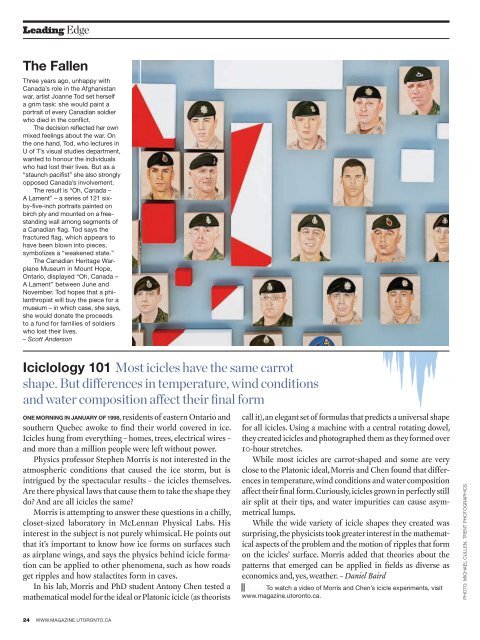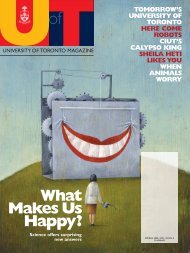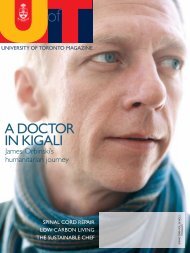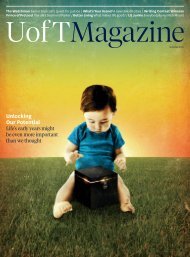The Next Big Idea 10 concepts that could - University of Toronto ...
The Next Big Idea 10 concepts that could - University of Toronto ...
The Next Big Idea 10 concepts that could - University of Toronto ...
Create successful ePaper yourself
Turn your PDF publications into a flip-book with our unique Google optimized e-Paper software.
Leading Edge<br />
<strong>The</strong> Fallen<br />
Three years ago, unhappy with<br />
Canada’s role in the Afghanistan<br />
war, artist Joanne Tod set herself<br />
a grim task: she would paint a<br />
portrait <strong>of</strong> every Canadian soldier<br />
who died in the conflict.<br />
<strong>The</strong> decision reflected her own<br />
mixed feelings about the war. On<br />
the one hand, Tod, who lectures in<br />
U <strong>of</strong> T’s visual studies department,<br />
wanted to honour the individuals<br />
who had lost their lives. But as a<br />
“staunch pacifist” she also strongly<br />
opposed Canada’s involvement.<br />
<strong>The</strong> result is “Oh, Canada –<br />
A Lament” – a series <strong>of</strong> 121 sixby-five-inch<br />
portraits painted on<br />
birch ply and mounted on a freestanding<br />
wall among segments <strong>of</strong><br />
a Canadian flag. Tod says the<br />
fractured flag, which appears to<br />
have been blown into pieces,<br />
symbolizes a “weakened state.”<br />
<strong>The</strong> Canadian Heritage Warplane<br />
Museum in Mount Hope,<br />
Ontario, displayed “Oh, Canada –<br />
A Lament” between June and<br />
November. Tod hopes <strong>that</strong> a philanthropist<br />
will buy the piece for a<br />
museum – in which case, she says,<br />
she would donate the proceeds<br />
to a fund for families <strong>of</strong> soldiers<br />
who lost their lives.<br />
– Scott Anderson<br />
Iciclology <strong>10</strong>1 Most icicles have the same carrot<br />
shape. But differences in temperature, wind conditions<br />
and water composition affect their final form<br />
One morning in January <strong>of</strong> 1998, residents <strong>of</strong> eastern Ontario and<br />
southern Quebec awoke to find their world covered in ice.<br />
Icicles hung from everything – homes, trees, electrical wires –<br />
and more than a million people were left without power.<br />
Physics pr<strong>of</strong>essor Stephen Morris is not interested in the<br />
atmospheric conditions <strong>that</strong> caused the ice storm, but is<br />
intrigued by the spectacular results – the icicles themselves.<br />
Are there physical laws <strong>that</strong> cause them to take the shape they<br />
do And are all icicles the same<br />
Morris is attempting to answer these questions in a chilly,<br />
closet-sized laboratory in McLennan Physical Labs. His<br />
interest in the subject is not purely whimsical. He points out<br />
<strong>that</strong> it’s important to know how ice forms on surfaces such<br />
as airplane wings, and says the physics behind icicle formation<br />
can be applied to other phenomena, such as how roads<br />
get ripples and how stalactites form in caves.<br />
In his lab, Morris and PhD student Antony Chen tested a<br />
mathematical model for the ideal or Platonic icicle (as theorists<br />
call it), an elegant set <strong>of</strong> formulas <strong>that</strong> predicts a universal shape<br />
for all icicles. Using a machine with a central rotating dowel,<br />
they created icicles and photographed them as they formed over<br />
<strong>10</strong>-hour stretches.<br />
While most icicles are carrot-shaped and some are very<br />
close to the Platonic ideal, Morris and Chen found <strong>that</strong> differences<br />
in temperature, wind conditions and water composition<br />
affect their final form. Curiously, icicles grown in perfectly still<br />
air split at their tips, and water impurities can cause asymmetrical<br />
lumps.<br />
While the wide variety <strong>of</strong> icicle shapes they created was<br />
surprising, the physicists took greater interest in the mathematical<br />
aspects <strong>of</strong> the problem and the motion <strong>of</strong> ripples <strong>that</strong> form<br />
on the icicles’ surface. Morris added <strong>that</strong> theories about the<br />
patterns <strong>that</strong> emerged can be applied in fields as diverse as<br />
economics and, yes, weather. – Daniel Baird<br />
To watch a video <strong>of</strong> Morris and Chen’s icicle experiments, visit<br />
www.magazine.utoronto.ca.<br />
photo: Michael Cullen, Trent Photographics<br />
24 WWW.MAGAZINE.UTORONTO.CA
















